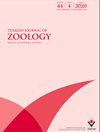浅水鱼类群落的粘液后生物多样性:以土耳其马尔马拉海为例
IF 1.3
4区 生物学
Q2 ZOOLOGY
引用次数: 0
摘要
:2020年11月至2021年8月,土耳其马尔马拉海发生了一次密集的粘液事件。在这项研究中,目的是了解粘液对沿海鱼类生物多样性的影响。为此,在2021年11月至2022年4月期间,在马尔马拉海周围12个等距站用实验性海滩围网对幼鱼和小型成鱼物种进行了采样。共采样了19科34种。约70%的鱼类总丰度为Atherina boyeri Risso,1810,Chelon auratus(Risso,1800)和Chelon saliens(Risso)。S5(Marmara Ereğlisi)和S11(Florya)的丰度最高,分别占总丰度的17.3%和14.2%。物种丰富度最高的是S4(Erdek)和S12(Yalova Tigem),分别有21个和18个物种。生物多样性指数最高的是S4、S8(卡拉卡贝河漫滩地区)和S12,而最低的是S9(Büyükçekmece)。S4和S8应受到渔业管理当局的监测和保护,因为它们是马尔马拉海的苗圃和保护区。当将沿海鱼类群落的生物量和生物多样性与粘液事件之前进行的先前研究进行比较时,可以说粘液并没有对招募成功产生不利影响。本文章由计算机程序翻译,如有差异,请以英文原文为准。
Postmucilage biodiversity of shallow water fish assemblages: A case study in the Marmara Sea, Turkey
: A dense mucilage event occurred between November 2020 and August 2021 in the Marmara Sea, Turkey. In this study, the aim was to understand the effect of mucilage on coastal fish biodiversity. For this purpose, juvenile and small-sized adult fish species were sampled with an experimental beach seine at 12 equally-spaced stations around the Marmara Sea between November 2021 and April 2022. In total, 34 species belonging to 19 families were sampled. Approximately 70% of the total fish abundance were Atherina boyeri Risso, 1810 , Chelon auratus (Risso, 1810) and Chelon saliens (Risso, 1810). Highest abundance was detected from S5 (Marmara Ereğlisi) and S11 (Florya) comprising 17.3% and 14.2% of total abundance, respectively. Maximum species richness was found at S4 (Erdek) and S12 (Yalova Tigem), with 21 and 18 species, respectively. The highest biodiversity indexes were seen at S4, S8 (Karacabey floodplain area) and S12, whereas the lowest biodiversity index was found at S9 (Büyükçekmece). S4 and S8 should be monitored and protected by fisheries management authorities due to being nursery and protection areas for the Sea of Marmara. When the biomass and biodiversity of the coastal fish assemblages were compared with previous studies conducted before the mucilage event, it can be said that mucilage did not adversely affect recruitment success.
求助全文
通过发布文献求助,成功后即可免费获取论文全文。
去求助
来源期刊

Turkish Journal of Zoology
ZOOLOGY-
CiteScore
2.30
自引率
10.00%
发文量
24
审稿时长
6-12 weeks
期刊介绍:
The Turkish Journal of Zoology is published electronically 6 times a year by the Scientific and Technological Research Council of Turkey (TÜBİTAK).
-Accepts English-language manuscripts in various fields of zoology including systematics, developmental biology, behaviour biology, animal models, molecular biology and molecular phylogeny, genomics, physiology (cell communication and signaling systems), biochemistry and immunohistochemistry, applied parasitology and pathology, nanobiotechnology, ecology, evolution, and paleontology of animal taxa.
-Contribution is open to researchers of all nationalities.
-Short communications are also welcome, such as reports of a preliminary nature or those including new records from specific localities or regions, and the editor reserves the right to decide that a paper be treated as a short communication.
-The papers that deal with purely checklists, new host and non-regional new locality records will not be consider for publication.
-Letters to the editor reflect the opinions of other researchers on the articles published in the journal. The editor may also invite review articles concerning recent developments in particular areas of interest.
 求助内容:
求助内容: 应助结果提醒方式:
应助结果提醒方式:


